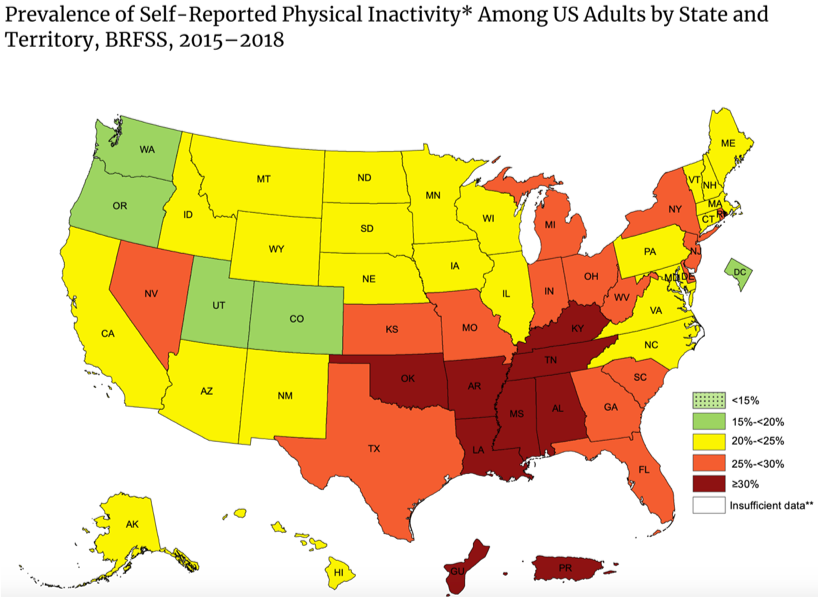How Physically Active is Your State? New Data From the CDC
By Jimmy McDermott

By Jimmy McDermott and Ursula Biba
Data from the CDC show that 17% of people in Colorado self-report an inactive lifestyle, up to 48% of people in Puerto Rico
The Centers for Disease Control and Prevention (CDC) released data on adult physical activity by state, showing rates of physical inactivity across the US.
Physical inactivity was self-reported through telephone interview surveys from 2015-2018, as part of the Behavioral Risk Factor Surveillance System (BRFSS). Respondents were classified as physically inactive if they answered “no” to the following question:
“During the past month, other than your regular job, did you participate in any physical activities or exercises such as running, calisthenics, golf, gardening, or walking for exercise?”
The data represent the percentage of survey respondents from each state who responded “no” and were therefore categorized as physically inactive.

-
Colorado, Washington, Utah, Oregon, and DC showed the lowest rates of physical inactivity, between 15% and 20%.
-
States with the highest rates of inactivity (30% and over) included Tennessee, Oklahoma, Louisiana, Alabama, Kentucky, Arkansas, and Mississippi.
-
Regionally, physical inactivity was the highest in the South at 28%, followed by the Northeast at 26%, the Midwest at 25%, and the West at 21%.
-
Racial and ethnic minorities show disproportionately higher levels of physical inactivity across the country. Frequency of physical inactivity was highest in Hispanics at 32%, followed by non-Hispanic blacks at 30%. Non-Hispanic whites showed a lower rate of 23%. This difference demonstrates inequalities in social determinants of health and the socioeconomic roots of physical inactivity (and subsequently, obesity and other related metabolic conditions).
All maps with physical activity data can be found on the CDC website.
How much should you exercise?
The US Department of Health and Human Services’ Physical Activity Guidelines for Americans was released in 2018. The guidelines suggest that the biggest health benefits occur when someone shifts from no physical activity to even a small amount of activity. There are many simple ways to get moving:
-
Take a walk after a meal – make it part of your lunch break!
-
Use the stairs instead of the elevator or escalator.
-
Do a few squats while brushing your teeth.
While a small increase in activity can make a difference, the guidelines do suggest that people build toward minimum weekly activity recommendations. Each week, adults should get either:
-
150-300 minutes (about 20-40 minutes per day) of moderate-intensity aerobic activity, like a brisk walk;
-
75-150 minutes of vigorous aerobic exercise like running or jogging (about 10-20 minutes per day); or,
-
Some combination of moderate- and high-intensity activity.
For adults, experts also strongly recommend lifting weights or other resistance training.
The guidelines find that doing all your exercise for the week in one or two days is no different for your body than spreading exercise out over three or more days. So, how you fit exercise into your lifestyle is entirely up to you.
Looking for ways to include more physical activity in your life?
Check out our articles:







